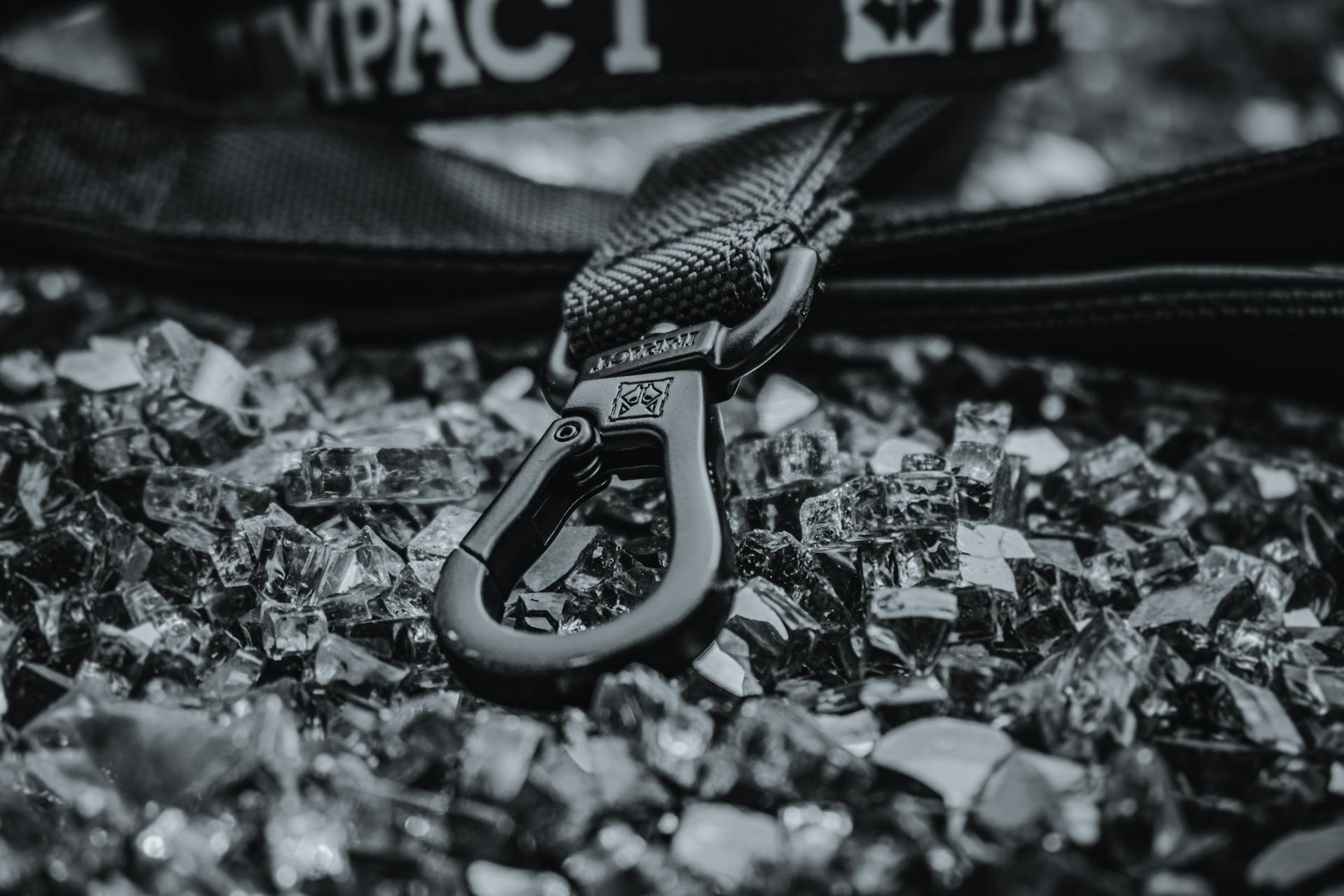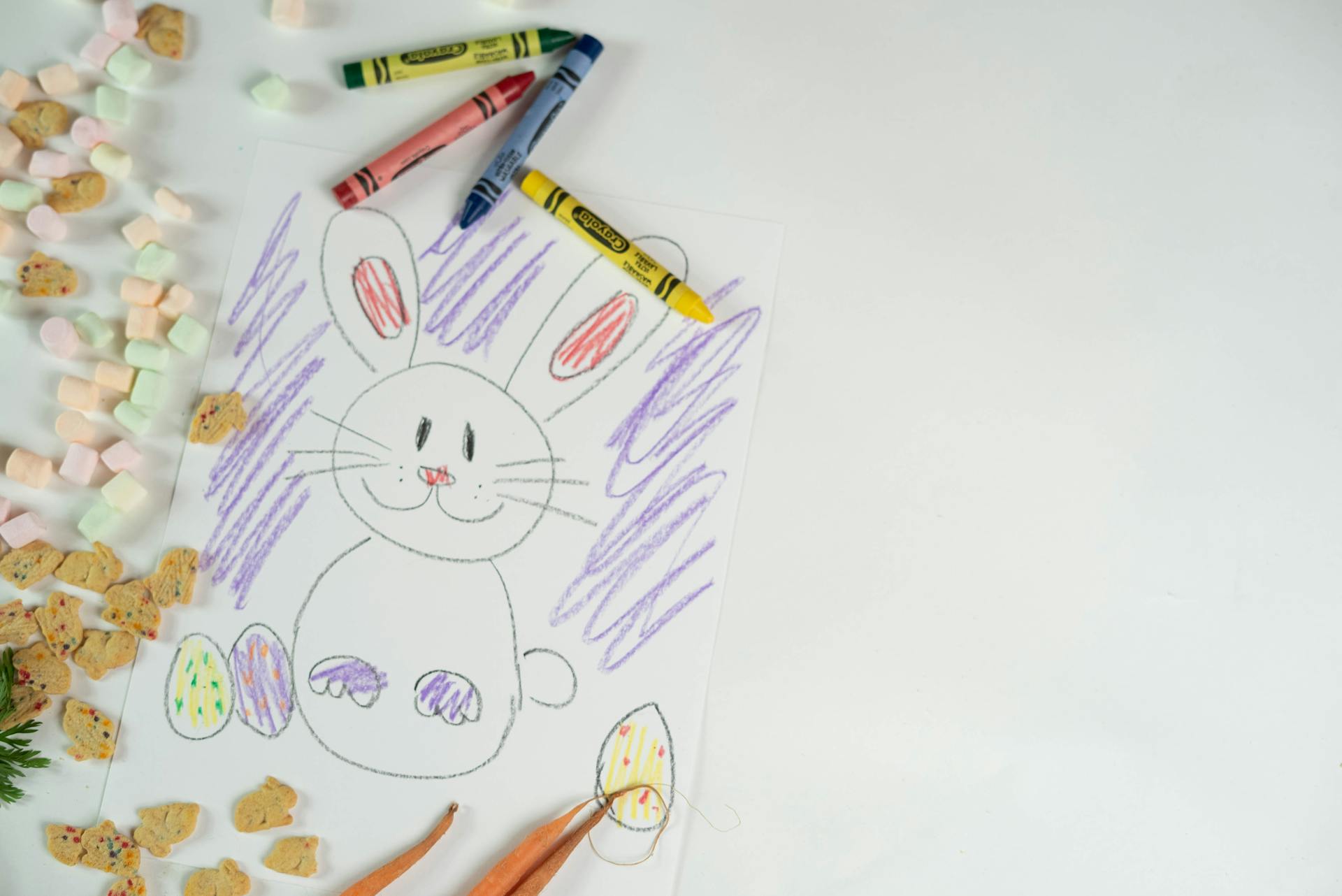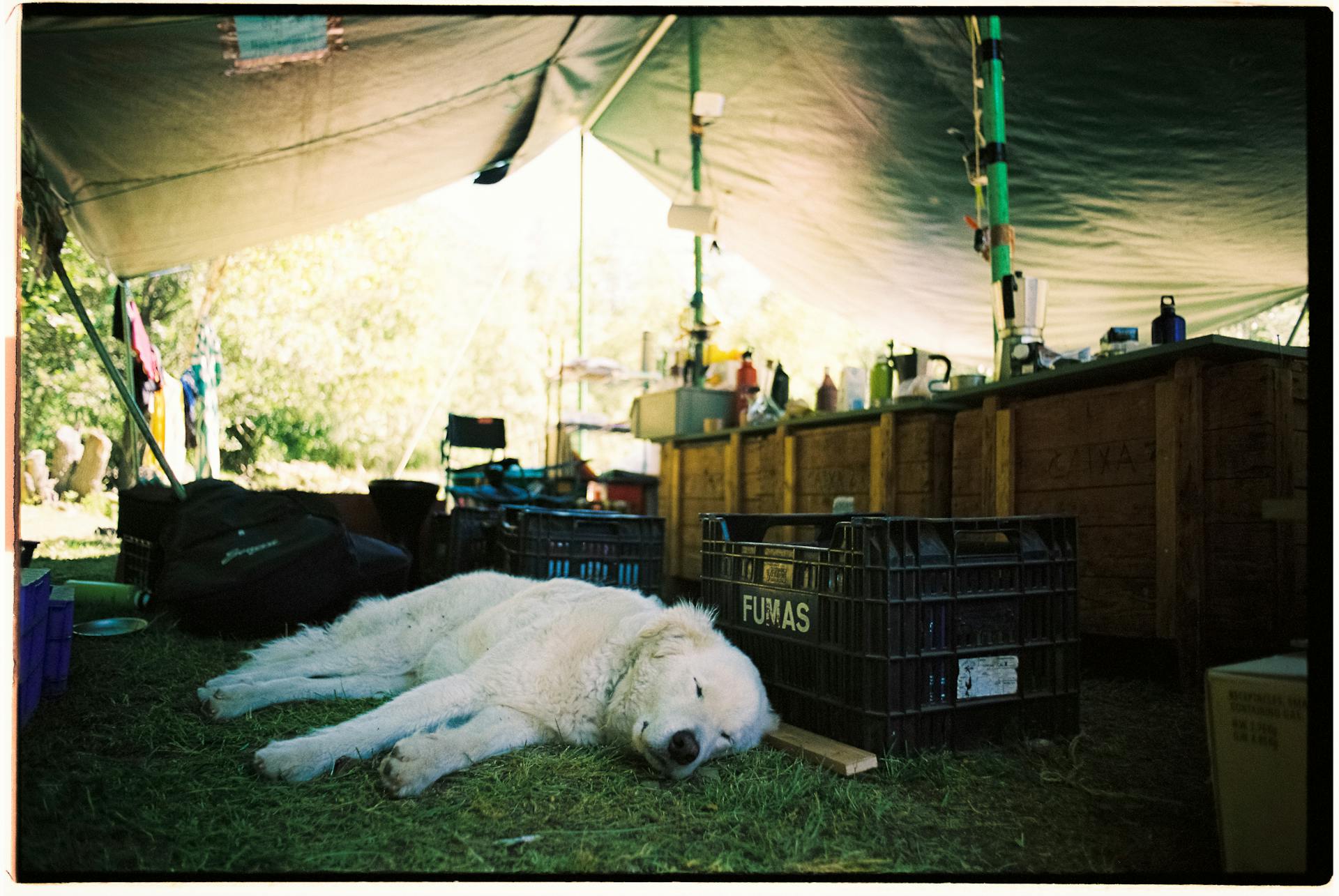
Crate training is a game-changer for German Shepherd owners. By providing a safe and comfortable space, you can help your puppy or adult dog feel secure and relaxed in their environment.
A crate should be large enough for your dog to stand up, turn around, and lie down comfortably. For puppies, a crate with a minimum size of 36 inches long, 24 inches wide, and 30 inches tall is recommended.
A crate can help with potty training by giving your puppy a designated area to hold their bladder and bowels. Consistency is key, so be sure to take your puppy out to the same spot each time to create a routine.
Crate training can also help with separation anxiety in adult dogs. By providing a safe space for them to retreat to when you're not home, you can help alleviate feelings of stress and anxiety.
Recommended read: Crate Training Older Dogs
Is Crate Training Necessary?
Crate training is a game-changer for German Shepherd puppies, providing a safe and comfortable space for them to relax and unwind.
Your dog needs a place to call their own, and a crate offers a sense of security and comfort, especially in a busy household.
Moving around town with your puppy can be a challenge, but a crate gives you a secure area to transport your pup safely.
Chewing is a natural part of puppyhood, and a crate helps protect your belongings from your puppy's sharp teeth.
Crate training can help your puppy learn to hold their bladder and bowels, making potty training a breeze.
By introducing a crate early on, you can set your puppy up for success and make training a whole lot easier.
You might enjoy: Dogs from Puppy Mills Behavior
Preparing Your Home
Dogs, especially German Shepherds, are social animals, so it's best to place their crate in a spot where you spend the most time. This allows them to feel connected to you and their surroundings.
Your German Shepherd should sleep in the same room as you, which helps develop a sense of trust and security. This is true even if you're leaving the house.
Some people choose to move the crate to different rooms, such as from the family room to the bedroom at night, while others keep it in one place. Ultimately, the most important thing is that your dog feels comfortable and secure in their crate.
You might like: What Does Place Mean in Dog Training
Location Selection
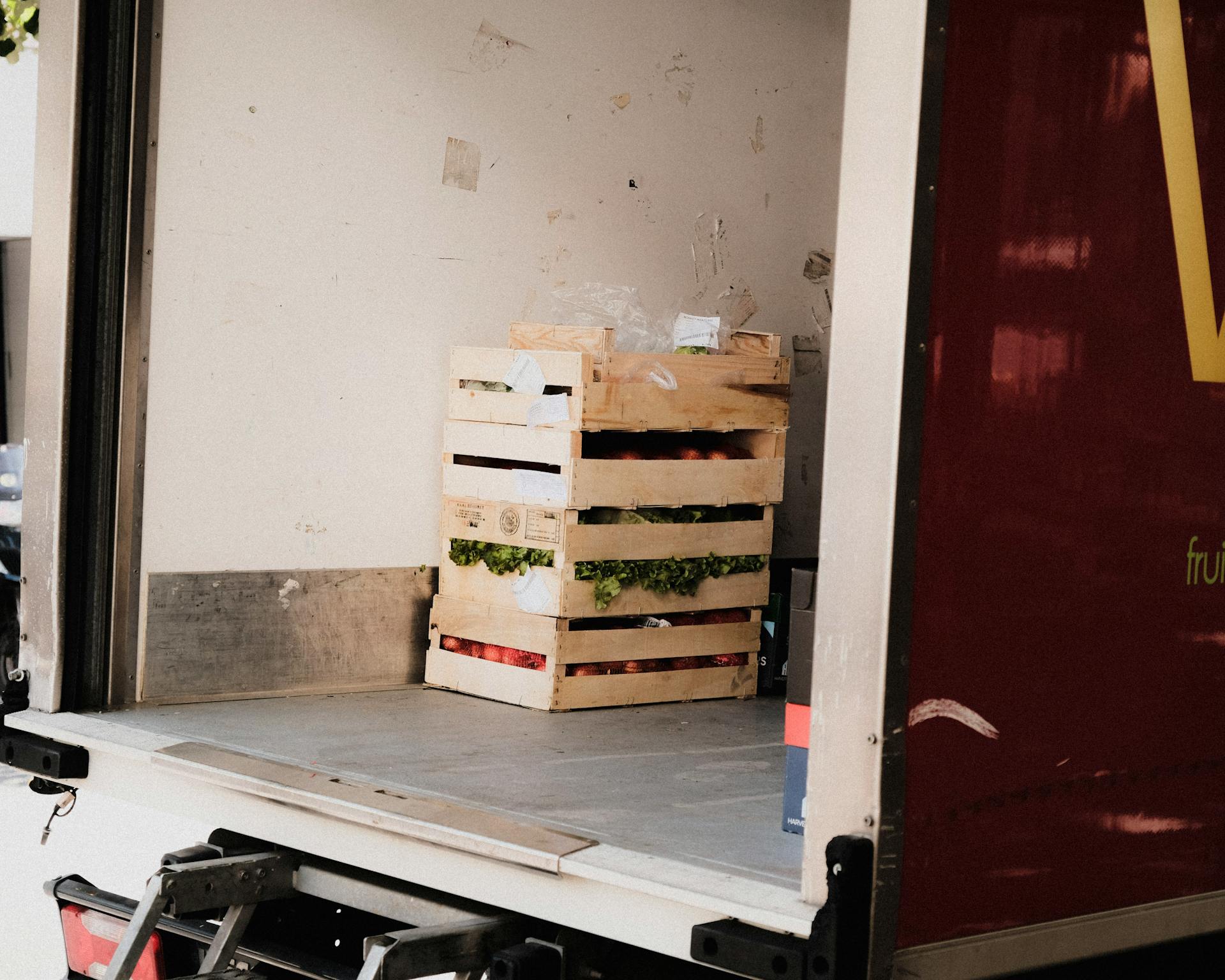
Choosing the right location for your German Shepherd's crate is crucial for their comfort and safety. Pick a spot that isn't in drafts and maintains a steady temperature to prevent your dog from getting sick.
Some areas will help your dog feel more secure and give them a comfort zone. Place their crate in a corner of a family room, out of the main pathway of foot traffic, so your dog can still spend time with you.
Temperature changes are uncomfortable for your dog, so avoid placing the crate right below a bright window. The sun's rays can get very hot and cause heat sickness in your dog.
Here are some tips to keep in mind when selecting a location for your dog's crate:
- Pick a spot that isn’t in drafts and maintains a steady temperature.
- Don’t place the crate right below a bright window.
- Place their crate in a corner of a family room, out of the main pathway of foot traffic.
Remember, your dog wants to spend time with you whenever it can, so try to place the crate in a room you use frequently. Your dog should sleep in the same room you do to develop a sense of trust and security.
Furnishing Your
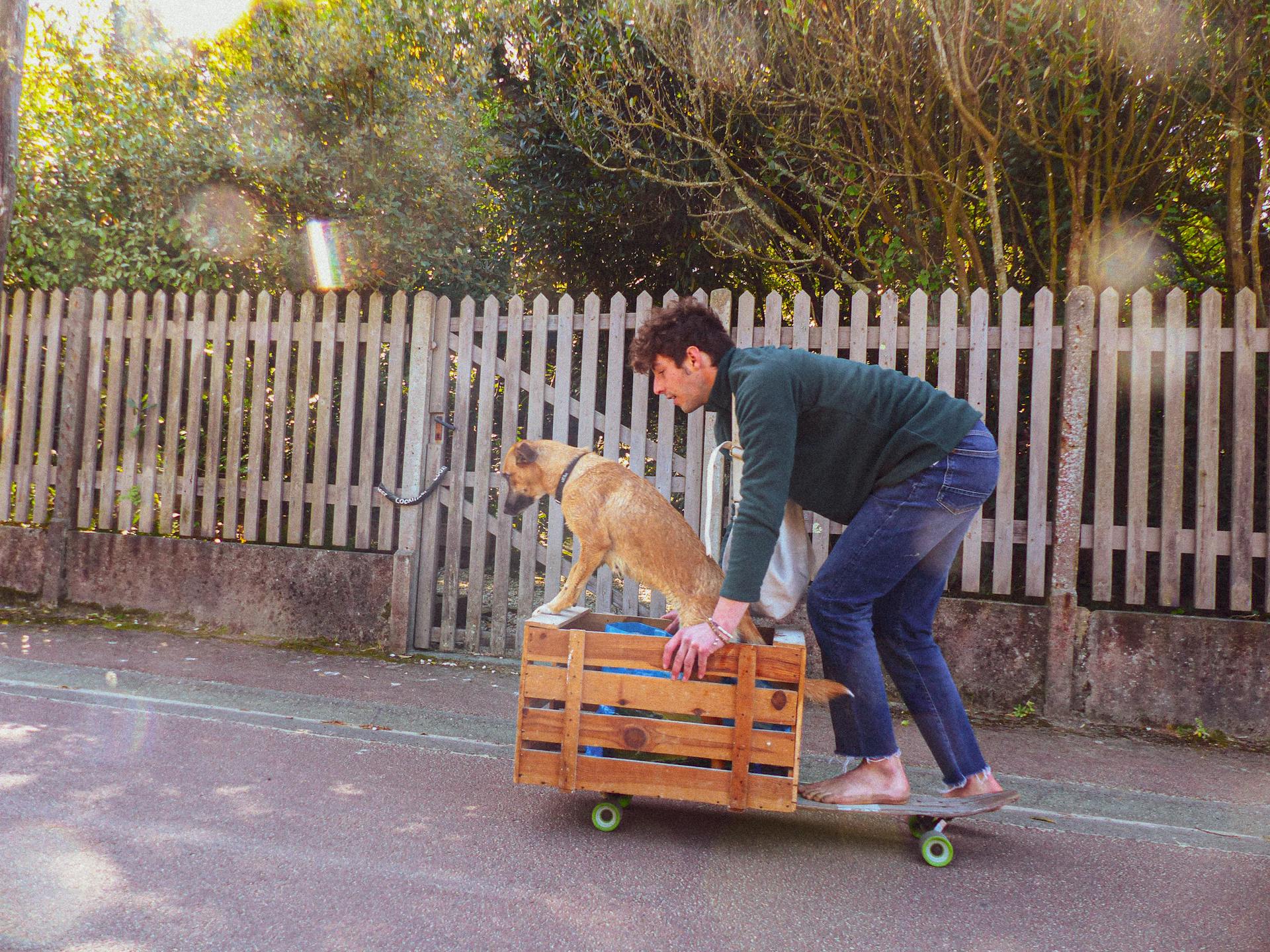
Furnishing your crate is a crucial step in making it a comfortable space for your dog.
You'll want to put a bed and/or blankets in the bottom of the crate, but be prepared for the bedding to get chewed.
A good idea is to get cheap blankets from Goodwill or the Salvation Army.
Some people even use an old towel or two to muffle the sound of the plastic tray clacking against the wire crate.
Always include some toys or comfort objects for the dog, like a nyla-bone or a special treat.
It's also a good idea to give the dog these items only when they're in the crate, so they associate the crate with positive experiences.
You might enjoy: Are Clickers Good for Dog Training
Positioning Your
Positioning your crate is crucial for your dog's comfort and safety. Dogs, especially German Shepherds, are social animals, so the crate must be where you spend the most time.
Positioning the crate in a high-traffic area allows your dog to feel secure and connected to the family. This is true even if you're leaving the house, as your dog will associate the crate with your presence.
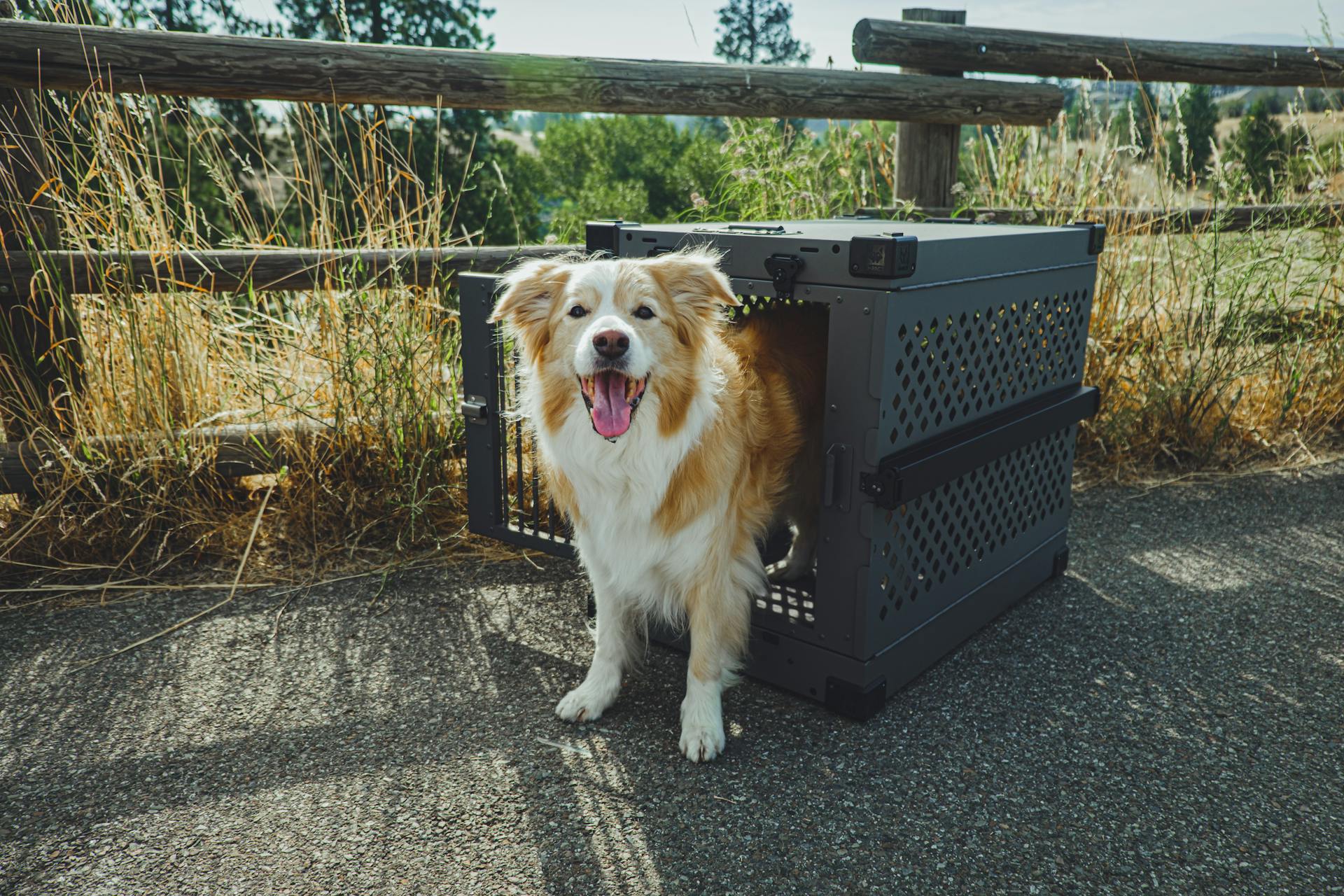
You can choose to place the crate in the family room every morning and then carry it to the bedroom at night, or leave it in the bedroom permanently. Some people even have two crates: one in the bedroom and one in the family room.
Remember, your dog should sleep in the same room as you do, allowing them to develop a sense of trust and security.
By placing the crate in a strategic location, you'll create a sense of security and comfort for your dog, making the crate training process smoother and more effective.
Getting Started
You'll want to ensure the crate you choose for your German Shepherd puppy is just the right size for the dog to stand up and turn around once he's an adult. Start with a smaller crate as a puppy and increase in size if you have additional crates available.
Set up the crate with lots of soft, comfortable bedding and some chew toys to keep your puppy entertained when he's awake inside the crate. Your German Shepherd puppy will also need lots of tasty treats as he gets to know his new crate and to reward him for making good choices in the crate.
Additional reading: Aussie Dog Training
Here are some key things to consider when setting up your puppy's crate:
- Choose a crate that's just the right size for your puppy.
- Start with a smaller crate and increase in size as your puppy grows.
- Provide soft, comfortable bedding and chew toys for entertainment.
- Offer tasty treats to help your puppy get comfortable with the crate.
Place the crate in a location where your puppy feels secure, such as your bedroom, initially. This will also allow you to hear if your puppy needs to go outside during the night.
Training Techniques
To start crate training your German Shepherd puppy, it's essential to set up a schedule and break down the training into small, achievable steps. This will help you and your dog stay on track and make the process less overwhelming.
Use treats and praise to encourage your puppy to enter the crate. Place treats just inside the door and gradually move them further in until your puppy is comfortable going all the way in. Praise and reward your puppy each time they enter the crate.
Start by creating positive associations with the crate by feeding your puppy's meals inside. Place the food bowl near the door initially and then gradually move it further inside. This will help your puppy view the crate as a positive place.
You might enjoy: No Treat Dog Training
Should Be Trained?
Should your German Shepherd be trained to use a crate? The answer is a definite yes. Exposing your dog to a crate is a necessary life skill that will benefit them in many ways.
In fact, crates for German Shepherds are designed with safety and comfort in mind, featuring chew-proof sides and plenty of ventilation. This makes them a comfortable place for your dog to rest and sleep.
However, it's essential to introduce the crate in a positive way. Don't shove your pup or dog inside as punishment, and never put your dog inside and slam the door out of anger or spite. This can create negative associations and make the crate a source of stress for your dog.
To avoid this, use the crate only when necessary, and don't leave your dog in it for extended periods. If you use the crate longer than you really need, your German Shepherd may begin to have anxiety, refuse to go into the crate, or exhibit unwanted behaviors like urination and excessive barking.
Discover more: What Treats to Use for Dog Training
Defining Tasks
To crate train your German Shepherd puppy, you'll need to set up an appropriate size crate in an area where you're comfortable with him sleeping. This crate will be their home for the night, so choose a spot that works for you.
It's essential to remember that a very young puppy may want to be close to you in your bedroom, so consider that when setting up the crate. If you have trouble sleeping with a whining puppy, you may want to put the crate in a spot away from your bedroom.
You'll need to establish a routine that includes regular feeding times, playtime, and potty breaks. This will help your puppy learn to hold their bladder overnight, and by the time they're ready to sleep through the night, your training should be complete.
As you start crate training, don't forget to go slowly and not force your puppy into the crate. This can be stressful for both you and your dog, so take it one step at a time.
Expand your knowledge: Why Are German Shepherds so Clingy
B. Positive Reinforcement
Positive reinforcement is key to successful crate training. Dogs and puppies love routines, and consistency is crucial in creating a stable home with expectations.
Reward your puppy with treats, praise, and affection for calm and quiet behavior in the crate. This encourages your puppy to view the crate as a positive place.
You can use treats to encourage your puppy to enter the crate. Place treats just inside the door to start, and gradually move them further inside until your puppy is comfortable going all the way in.
Praise and reward your puppy each time they enter the crate. This positive reinforcement helps build trust and a positive association with the crate.
Feeding your puppy's meals inside the crate can also create a positive association. Initially, place the food bowl near the door, then gradually move it further inside.
Here's a summary of positive reinforcement techniques to try:
- Use treats and praise to encourage calm and quiet behavior in the crate.
- Gradually move treats further inside the crate to help your puppy feel comfortable.
- Feed your puppy's meals inside the crate to create a positive association.
- Always use positive reinforcement to avoid creating anxiety or unwanted behaviors.
By using positive reinforcement, you can help your puppy view the crate as a safe and comfortable space. This will make crate training easier and more effective in the long run.
Establish a Routine
Establishing a routine is key to successful crate training. This helps your German Shepherd puppy understand that the crate is a place for rest and relaxation.
Encourage your puppy to take naps and sleep at night in the crate. A consistent sleep schedule will help your puppy feel secure and develop good sleep habits.
Consistency is crucial in crate training, so stick to a regular schedule. This will help your puppy understand what is expected of them.
If your puppy whines or barks in the crate, remain patient and consistent. Avoid letting your puppy out while they are making noise, as this reinforces the behavior.
By sticking to a regular routine, you'll be able to establish a sense of normalcy for your puppy. This will make the crate training process much smoother and more effective.
Broaden your view: Dog Diaper Training
Tips and Considerations
To ensure a smooth gsd crate training experience, it's essential to establish a routine that works for you and your puppy. Find a crate training schedule that suits your lifestyle and stick to it.
A consistent feeding time and schedule can help control elimination times, making potty training easier. Set specific walking times, especially when beginning potty training.
Remember, crate training is not about punishment, but about creating a safe space for your puppy to relax and learn. Don't leave your puppy in their crate for long periods as punishment.
To help your puppy adjust to crate time, start with short periods, such as 10 to 15 minutes, and gradually increase the duration as they become more comfortable. Ensure you're providing plenty of opportunities for exercise, interaction, and stimulation outside of the crate.
Here are some key considerations to keep in mind:
- Crates should not be used as punishment.
- Gradually increase crate time to ensure your puppy adjusts comfortably.
- Provide plenty of opportunities for exercise, interaction, and stimulation outside of the crate.
By following these tips and considerations, you'll be well on your way to successful gsd crate training.
Why Is Great
Crate training a German Shepherd puppy is a great idea because it provides a safe spot for your puppy to find comfort and relax away from the busy family.

A crate is essential for travel and transport, allowing you to secure your pup safely for road trips or vacations.
Your German Shepherd puppy will go through a chewing stage, and a crate works wonders in protecting your belongings and keeping your puppy safe.
Crate training almost guarantees quicker success in housebreaking by building upon your puppy's need to not soil where they sleep or eat.
A crate can serve as your German Shepherd's personal den, where they can retreat to when they are overwhelmed or tired, tapping into their natural den instinct.
Crate training plays a key role in the housebreaking process, encouraging your puppy to control their bladder and bowel movements, which is essential for indoor living.
A crate is the best place for your puppy when you are not actively engaging with them, solving many training issues and helping to raise a well-adjusted, happy German Shepherd.
Check this out: Crate Training Australian Shepherd
Keep Your Entertained
To keep your German Shepherd puppy entertained in their crate, provide safe toys and chews. This will help prevent boredom and reduce the likelihood of your puppy associating the crate with negative experiences.
You can start by introducing a few toys and chews to the crate, and then gradually rotate them to keep things interesting. For example, you can give your puppy a rubber toy in the morning and a stuffed animal in the afternoon.
Here are some safe toys and chews you can consider:
- Rubber toys
- Stuffed animals
- Interactive puzzle toys
- Long-lasting chews like bully sticks or raw hide
Remember to choose toys and chews that are suitable for your puppy's age and size, and to supervise them to ensure their safety.
Dealing with Whining
Whining in the crate is a common issue, especially in the early stages of crate training. Your GSD might whine because they're not comfortable with the crate or because they're trying to get your attention.
Don't let your GSD out while they're whining, as this can reinforce the idea that whining leads to being let out. Instead, wait until your GSD is calm and quiet before letting them out.
If your GSD consistently shows reluctance about entering the crate or their whining persists, it's time to revisit your crate training process. Ask yourself if the crate is comfortable and inviting, and if you're not using it as a means of punishment.
Here's an interesting read: Gsd Guard Dog Training
Forcing your GSD into the crate or using it as punishment will only create a negative association and make training more difficult. Patience and positive reinforcement are key in helping your GSD overcome any whining or reluctance.
Here are some things to check if your GSD is whining in the crate:
- Is the crate comfortable and inviting?
- Are you gradually increasing crate time?
- Are you using the crate as a means of punishment?
By addressing these issues and providing a positive environment, you can help your GSD overcome whining and reluctance in the crate.
Spending More Time with Your Dog
Spending more time with your dog is crucial for their emotional and mental well-being. You can start by introducing a crate as a comfortable space for them to relax.
Begin by leaving them in the crate for longer periods, building up time slowly. This will help them get used to being alone without feeling anxious. A good starting point is to leave them in for 5 to 10 minutes, and then gradually increase the time.
To make the experience more enjoyable, call them over to the crate with a specific command, such as "crate", and reward them with a treat when they enter. This positive reinforcement will help them associate the crate with good things.
As you increase the time they spend in the crate, you can also start leaving them alone in the room for a few minutes. This will help them get used to being alone without your presence. A good rule of thumb is to start with short periods, such as 5-10 minutes, and gradually increase the time.
Here's a rough guide to help you increase the time your dog spends in the crate:
- 5-10 minutes: Leave them in the crate with you in the same room
- 10-15 minutes: Leave them in the crate with you in another room
- 15-30 minutes: Leave them in the crate while you're away from the room
- 30 minutes and beyond: Leave them in the crate while you're away from the house
Remember, every dog is different, so be patient and adjust the time accordingly. With consistency and positive reinforcement, your dog will learn to enjoy their time in the crate.
Frequently Asked Questions
Should I crate my German Shepherd at night?
Yes, you can crate your German Shepherd at night, but it's also a good idea to provide regular breaks and exercise during the day to prevent prolonged confinement.
How do I stop my German Shepherd puppy from crying at night?
To stop your German Shepherd puppy from crying at night, establish a consistent routine and wear them out with daily exercise to ensure they're physically and mentally exhausted by bedtime. Crate training and limiting distractions can also help prevent nighttime whining.
Sources
- https://www.shepherdsense.com/german-shepherd-puppy-crate-training/
- https://wagwalking.com/training/crate-train-a-german-shepherd-puppy-at-night
- https://www.caninepetrescue.com/about-gsds/crate-training-your-dog/
- https://guardianworkingshepherds.com/blog/the-easiest-and-fastest-way-to-crate-train-your-working-line-german-shepherd-puppy/
- https://germanshepherdresources.com/german-shepherd-crate-training/
Featured Images: pexels.com
